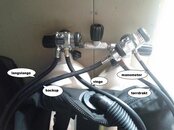Oops, should be bigger volume reg, not diaphragm, I was still thinking diaphragm from the first stage issue.
The bigger the reg volume the easier it is to breath as it gives a larger buffer between the first stage opening and closing so allows for a smoother transmission. I'm more familiar with the 250HP but can't see the design being that different? I'll look into that one.
The bigger diaphragm should also help in theory, but that wouldn't be a main driving factor, nor would it be something anyone could sense without some kind of measurement.




